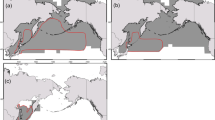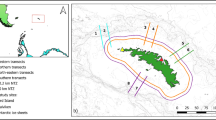Abstract
The Japanese flying squid (Todarodes pacificus) is an important fishery resource in East Asia, including Japan, China, and Korea. Recent studies have suggested that it exhibits significant interannual variation with a close relationship with environmental variables, among which water temperature has an apparent influence on its spawning, hatching, and growth. Therefore, we need to understand how the Japanese flying squid in the Japan Sea (JS) will be affected by global warming. Based on particle tracking methods, we simulated migration and individual growth of Japanese flying squid from spawning to juveniles (182 days) in six cases: one for high-level catch years (1960–1966), one for low-level catch years (2008–2014), and four for the future, including two for 50 years (2056–2062) and two for 100 years from now (2104–2110) under the warming scenario of RCP2.6 and RCP8.5, respectively. The simulations showed that the number of squid increased with warming. The main reason for the increase was the warming of the JS, which increased the survival rate of autumn- and winter-spawning cohorts. In addition, the model also demonstrated the potential effects of warming on the physiological process of the early life stage of the Japanese flying squid.








Similar content being viewed by others

References
Barange M, Merino G, Blanchard JL, Scholtens J, Harle J, Allison EH et al (2014) Impacts of climate change on marine ecosystem production in societies dependent on fisheries. Nat Clim Chang 4(3):211
Blanchard JL, Jennings S, Holmes R, Harle J, Merino G, Allen JI et al (2012) Potential consequences of climate change for primary production and fish production in large marine ecosystems. Philos Trans R Soc B: Biol Sci 367(1605):2979–2989
Cheung WW (2018) The future of fishes and fisheries in the changing oceans: fishes and fisheries in the changing oceans. J Fish Biol 92:790–803
Fisheries Agency of Japan and Japan Fisheries Research and Education Agency (2018) Resource evaluation of Japanese common squid on Autumn group 2018. pp, 48 http://abchan.fra.go.jp/digests2018/details/201819.pdf (in Japanese)
Free CM, Thorson JT, Pinsky ML, Oken KL, Wiedenmann J, Jensen OP (2019) Impacts of historical warming on marine fisheries production. Science 363(6430):979–983
Hirose N, Takayama K, Moon JH, Watanabe T, Nishida Y (2013) Regional data assimilation system extended to East Asian marginal seas. Umi to Sora 89:43–51
Japan Meteorological Agency, (2018). Climate Change Monitoring Report 2017
Kang YS, Kim JY, Kim HG, Park JH (2002) Long-term changes in zooplankton and its relationship with squid, Todarodes pacificus, catch in Japan/East Sea. Fish Oceanogr 11(6):337–346
Kidokoro H (2003) Stock assessment and management method for the Japanese common squid in Japan. Suisankanri Danwakaiho 30:18–35
Kidokoro H, Goto T, Nagasawa T, Nishida H, Akamine T, Sakurai Y (2010) Impact of a climate regime shift on the migration of Japanese common squid (Todarodes pacificus) in the Sea of Japan. ICES J Mar Sci 67(7):1314–1322
Kidokoro H, Shikata T, Kitagawa S (2014) Forecasting the stock size of the autumn cohort of Japanese common squid (Todarodes pacificus) based on the abundance of trawl-caught juveniles. Hidrobiológica 24(1)
Kim JJ, Stockhausen W, Kim S, Cho YK, Seo GH, Lee JS (2015) Understanding interannual variability in the distribution of, and transport processes affecting, the early life stages of Todarodes pacificus using behavioral-hydrodynamic modeling approaches. Prog Oceanogr 138:571–583
Kim H, Takayama K, Hirose N, Onitsuka G, Yoshida T, Yanagi T (2019) Biological modulation in the seasonal variation of dissolved oxygen concentration in the upper Japan Sea. J Oceanogr 75(3):257–271
Kishi MJ, Nakajima K, Fujii M, Hashioka T (2009) Environmental factors which affect growth of Japanese common squid, Todarodes pacificus, analyzed by a bioenergetics model coupled with a lower trophic ecosystem model. J Mar Syst 78(2):278–287
Kobayashi S, Ota Y, Harada Y, Ebita A, Moriya M, Onoda H et al (2015) The JRA-55 reanalysis: general specifications and basic characteristics. J Meteorol Soc Jpn Ser II 93(1):5–48
Lee H-J, Yoon J-H, Kawamura H, Kang H-W (2003) Comparison of RIAMOM and MOM in modeling the East Sea/Japan Sea circulation. Ocean Polar Res 25:287–302
Mao X, Guo X, Wang Y, Takayama K (2019) Influences of global warming on the larval survival and transport of snow crab (Chionoecetes opilio) in the sea of Japan. Sustainability 11(8):2198
Mizuta R, Arakawa O, Ose T, Kusunoki S, Endo H, Kitoh A (2014) Classification of CMIP5 future climate responses by the tropical sea surface temperature changes. Sola 10:167–171
Moore JK, Fu W, Primeau F, Britten GL, Lindsay K, Long M et al (2018) Sustained climate warming drives declining marine biological productivity. Science 359(6380):1139–1143
Moss RH, Edmonds JA, Hibbard KA, Manning MR, Rose SK, Van Vuuren DP et al (2010) The next generation of scenarios for climate change research and assessment. Nature 463(7282):747–756
Murata M (1989) Population assessment, management and fishery forecasting for the Japanese common squid Todarodes pacificus. In: Caddy JR (ed) Marine invertebrate fisheries: their assessment and management. John Wiley and Sons, New York, pp 613–636
Peters GP, Andrew RM, Boden T, Canadell JG, Ciais P, Quéré CL et al (2012) The challenge to keep global warming below 2°C. Nat Clim Chang 3(1):2–4
Pörtner HO, Knust R (2007) Climate change affects marine fishes through the oxygen limitation of thermal tolerance. Science 315(5808):95–97
Rosa AL, Yamamoto J, Sakurai Y (2011) Effects of environmental variability on the spawning areas, catch, and recruitment of the Japanese common squid, Todarodes pacificus (Cephalopoda: Ommastrephidae), from the 1970s to the 2000s. ICES J Mar Sci 68(6):1114–1121
Sakurai Y, Bower JR, Nakamura Y (1998) Effect of temperature on development and survival of Todarodes pacificus embryos and paralarvae. Oceanogr Lit Rev 3(45):556
Sakurai Y, Kiyofuji H, Saitoh S, Goto T, Hiyama Y (2000) Changes in inferred spawning areas of Todarodes pacificus (Cephalopoda: Ommastrephidae) due to changing environmental conditions. ICES J Mar Sci 57(1):24–30
van Vuuren DP, Edmonds J, Kainuma M, Riahi K, Thomson A, Hibbard K et al (2011) The representative concentration pathways: an overview. Clim Chang 109(1):5–31
Wakamatsu S, Oshio K, Ishihara K, Murai H, Nakashima T, Inoue T (2017) Estimating regional climate change uncertainty in Japan at the end of the 21st century with mixture distribution. Hydrol Res Lett 11(1):65–71
Watanabe K, Sakurai Y, Segawa S, Okutani T (1996) Development of the ommastrephid squid Todarodes pacificus, from fertilized egg to the rhynchoteuthion paralarva. Am Malacol Bull 13(1/2):73–88
Acknowledgements
We want to thank Prof. Michio J. Kishi who provided us the individual growth module of squid, Prof. Yasunori Sakurai for his advice on our simulations, and Prof. Naoki Hirose at Kyushu University who support the work of Dr. Katsumi Takayama.
Funding
This study was financially supported by the Environment Research and Technology Development Fund (S-13) of the Ministry of the Environment, Japan; by the Ministry of Education, Culture, Sports, Science and Technology (MEXT), Japan, to a project on Joint Usage/Research Center - Leading Academia in Marine and Environment Pollution Research (LaMer); and by the National Natural Science Foundation of China (41576010).
Author information
Authors and Affiliations
Corresponding author
Additional information
Publisher’s note
Springer Nature remains neutral with regard to jurisdictional claims in published maps and institutional affiliations.
Rights and permissions
About this article
Cite this article
Ji, F., Guo, X., Wang, Y. et al. Response of the Japanese flying squid (Todarodes pacificus) in the Japan Sea to future climate warming scenarios. Climatic Change 159, 601–618 (2020). https://doi.org/10.1007/s10584-020-02689-3
Received:
Accepted:
Published:
Issue Date:
DOI: https://doi.org/10.1007/s10584-020-02689-3



